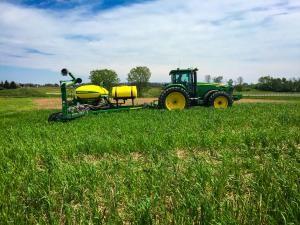Just a few miles off the Lake Michigan shoreline, father-and-son farming team, Roger and Brian Karrels, operate a cash grain operation growing corn, soybeans, and winter wheat on about 1,600 acres in northern Ozaukee County known as Lake Breeze Farms. In the earlier days of operation, their typical tillage would include fall chisel plow, followed by several passes with a field cultivator and no green covers going into winter to protect the soil. But in 2018, the Karrels joined the Ozaukee County Demonstration Farm Network, a project under the GLRI, to showcase and demonstrate leading-edge conservation practices in cooperative effort with the U.S. Department of Agriculture Natural Resource Conservation Service and the Ozaukee County Department of Land & Water Management.
“We’ve definitely seen an improvement in soil quality, reduction of soil erosion and water infiltration with the addition of cover crops, reduced and no-till to our operation,” said Brian.
In 2020, the Karrels installed a monarch pollinator field on their farmstead. Brian admitted that planting the wildflower field tested his knowledge of his planter to get the seeding rate just right and questioned if the curated pollinator planting mix would grow. But with the knowledge and advice from their local NRCS staff, Brian was able to successfully remove the previous grass/hay cover, plant a diverse monarch pollinator seed mix and mow to manage weeds the first year. Having the pollinator planting nearby has brought back fond memories for Brian’s wife Deanna, who is excited to be able to search for caterpillars with their grandchildren as they grow up and appreciate the natural world around them.
“If we can show that no-till, cover crops and other soil health practices can work to be profitable on heavy clay soils, within 3 miles of Lake Michigan and all of its micro-climate effects, we can demonstrate that they can be implemented anywhere,” said Michael Patin, local NRCS District Conservationist.
As for the monarch pollinator habitat, the Karrels are looking forward to guiding the next generation of caterpillar caretakers.


